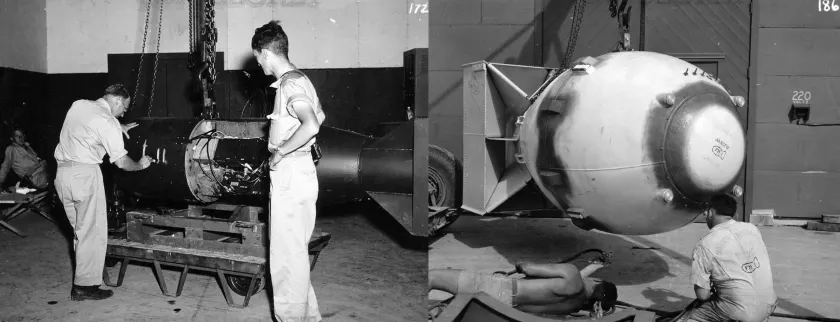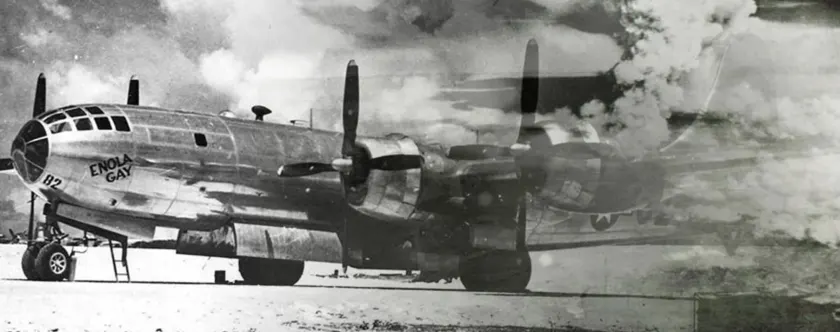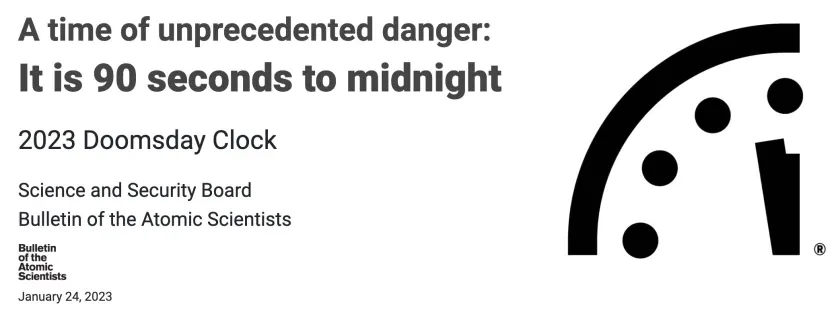Last week, President Joe Biden visited Hiroshima. He was the second sitting president of the United States to make the pilgrimage to the site of the most destructive moment in human history. On Aug. 6, 1945, at 8:14 a.m. local time, the United States dropped a uranium 235 gun-mechanism atomic bomb on Hiroshima. Three days later, the U.S. dropped a plutonium implosion device on Nagasaki.
President Barack Obama visited Hiroshima in 2016. Two other U.S. presidents have visited the site, Richard Nixon in April 1964, four years before he was elected president, and Jimmy Carter in 1984, four years after he left the presidency. No president has apologized to the people of the two cities or the people of Japan for the atomic bombings of 1945, perhaps in part because that would detonate a political firestorm among some World War II veterans and members of the political right.

Workers completing preparation of Little Boy Unit L-11 (left) and Fat Man (right) which would be dropped on the Japanese cities of Hiroshima and Nagasaki respectively in August 1945.(atomicarchives.com)

On August 6, 1945, the crew of a modified Boeing B-29 Superfortress named Enola Gay dropped the first atomic bomb used in warfare, called Little Boy, on the city of Hiroshima, Japan. (Public Domain, via Wikimedia Commons)
The Japanese have determined that 333,907 people died at Hiroshima and Nagasaki in the blasts of August 1945, or from complications of the detonations in the decades that followed. Most historians agree that approximately 60,000-70,000 Japanese citizens, most of them civilians, were instantaneously vaporized in each attack, when “Little Boy” at Hiroshima and “Fat Man” at Nagasaki exploded, without warning, in relatively intact Japanese cities that had so far avoided America’s intense campaign of “conventional bombing.”
Flanked by six other leaders of the G7 and two representatives of the European Union, President Biden joined his fellow heads of state in laying beautiful white wreaths at the Cenotaph for the Atomic Bomb Victims in Hiroshima’s Peace Memorial Park. The leaders also planted a cherry tree sapling, propagated from a tree that somehow survived the Hiroshima catastrophe. As the solemn ceremony unfolded last week (no speeches, thank goodness), Japanese survivors of the two atomic blasts, known as hibakusha, looked on in silence. As with Holocaust survivors and World War II veterans, the moment will come sometime mid-century when the last atomic survivors have died.
Among the other leaders at the ceremony at the Cenotaph were Fumio Kishida of Japan, Justin Trudeau of Canada, Rishi Sunak of Britain and Emmanuel Macron of France. Macron, Sunak and Trudeau are the first sitting leaders of their respective countries to visit Hiroshima.
Age Before Wisdom?
What I noticed in viewing video of the wreath ceremony, is that virtually every other world leader is younger than ours (or his principal domestic rival).

From left to right, Justin Trudeau of Canada, Rishi Sunak of Britain, Volodymyr Zelenskyy of Ukraine and Emmanuel Macron of France at the G7 Summit in Hiroshima, Japan (G7 Pool – ZUMA and AFPPIX)
Trudeau looks like a great boy next to the more staid senior citizens and octogenarians of the G7, and France’s Macron seems about the right age for the leader of one of the most important countries in the world. So, too, Britain’s Sunak, who is just 43. The United States, which has celebrated youth like a cult for the last 150 years, is now governed by people born in another generation.
President Volodymyr Zelenskyy of Ukraine made a surprise visit to Japan Saturday to meet with (and upstage) the G7 leaders, including President Biden. No head of state fears a nuclear attack more than Zelenskyy, well-aware that Russia’s saber-rattling President Vladimir Putin has threatened to use atomic devices against the armies and perhaps the civilians of Ukraine in his war to annex the whole of the republic, which was part of the USSR for more than 70 years. Western diplomats and historians do not rule out the possibility that Putin might actually use nuclear weapons, probably tactical field warheads, as his nation’s so-far failed invasion gets more costly in every way. A historian I knew told me long ago, “Never back someone into a corner they cannot get out of except over the top of you.” In extremity, who knows what Putin might do? Nobody can predict what would happen if Russia dropped a nuclear weapon on Ukraine, but it would be impossible for Ukraine and the West to simply absorb such an attack without responding with something approaching proportional retaliation.
Ironically, on the day the leaders of the principal First World nations participated in a peace ceremony designed to reinforce the conviction that such weapons must never be used again, the U.S. authorized the delivery of F-16 fighter jets to Ukraine to help it resist the Russian onslaught. In other words, the advent of F-16s in the already quasi-apocalyptic Ukraine war means that the mayhem and the destruction are likely to get much worse before they begin to diminish.
One irony of Putin’s atomic threats is that when the Soviet Union collapsed, on Dec. 26, 1991, Ukraine possessed approximately one-third of the USSR’s vast nuclear arsenal: warheads, delivery systems, including 175 ICBMs, and research and development facilities. With 1,700 warheads within its borders, from 1991-1994 Ukraine was the world’s third largest nuclear power. After all sorts of diplomatic and technological complications, including Russian threats, Ukraine either returned or destroyed its entire nuclear inventory. Had Ukraine retained some of its weapons and figured out how to deploy them, Putin (or any other invader) might well have hesitated to attack a nuclear-armed sovereign nation-state.
The Club
The so-called global nuclear club now numbers nine: the United States, Russia, Great Britain, France, China, North Korea, Pakistan, India and Israel. According to the Stockholm International Peace Research Institute, the world arsenal now comprises 15,850 devices, 4,300 deployed with operational forces. South Africa had nuclear weapons during the height of the Cold War, but it relinquished its small arsenal in 1989, one year before Nelson Mandela was released from prison. The United States now has 5,244 nuclear devices, down dramatically from the peak in 1967, when there were 31,255 nuclear weapons in our arsenal. Russia has 5,889, China 400, France 290, Britain 225, Pakistan 170, India 164, Israel 90 (though they don’t admit it) and North Korea 30.
Iran may or may not be continuing to try to develop a nuclear weapon clandestinely. Most experts believe the Islamic nation has curtailed or suspended its nuclear program to ease sanctions imposed by much of the rest of the world. The exact state of Iran’s nuclear program is unclear. Iran’s argument is that its bitter enemy Israel has nuclear weapons, so its only guarantee of not being invaded or subjected to nuclear blackmail will be in having its own arsenal.
Other Visitors to Hiroshima, Including Oppenheimer
Douglas MacArthur visited in 1959, Jean-Paul Sartre in 1966, Edward Kennedy in 1978, Jane Fonda in 1981, Mother Teresa in 1985, Andrei Sakharov in 1989, Mikhail Gorbachev in 1992, the Dalai Lama in 1995, Václav Havel in 1995, Elie Wiesel in 1995, Shimon Peres in 1997, Seamus Heaney in 1998, U.S. Rep. Barbara Lee in 2002, Howard H. Baker in 2004, Caroline Kennedy in 2015, and John Kerry in 2016.

In 1954, the Atomic Energy Commission revoked Dr. J. Robert Oppenheimer’s security clearance. In restoring it posthumously 68 years later, the federal government attempts to atone for its own black mark by removing the black mark on Oppenheimer’s record.
The father of the atomic bomb, J. Robert Oppenheimer visited Japan in September 1960, just weeks before John F. Kennedy was elected president of the United States. Oppenheimer had been invited by the Japan Committee for Intellectual Interchange. Oppenheimer’s friends warned him not to go, that he might be exposed to protest, hostility and possibly even violence if he made the trip just 15 years after Hiroshima and Nagasaki. Oppenheimer, who had tremendous moral courage, believed it was his duty to accept the invitation. He did not visit the two bomb sites. That could not be arranged. Oppenheimer was treated with grace and hospitality during his time in Japan. No incidents marred the journey.
As he was about to leave the country, he found himself in an impromptu news conference at the Tokyo airport. Oppenheimer found the barrage of flash bulbs oppressive. When things settled, a Japanese reporter said, “I should like to ask you — although the question may be a little bit naïve — to say a few words about your feelings in coming to Japan as a man responsible for the development of the bombs that were dropped on Hiroshima and Nagasaki.”
The cerebral Oppenheimer was never one to speak without thinking it through first. He said, “It is not a naïve question.” After a brief period of silence he said, “I do not think coming to Japan changed my sense of anguish about my part in this whole piece of history. Nor has it fully made me regret my responsibility for the technical success of the enterprise.”
He paused, then tried to summarize: “It isn’t that I don’t feel bad. It is that I don’t feel worse tonight than last night.”
Since Aug. 9, 1945, until today (77 years, nine months, 19 days), there has never again been a nuclear detonation in war. After World War II ended, Oppenheimer warned that the world must never again use a nuclear device in war, because the minute that threshold was passed, nuclear warfare would be “normalized” and it would be impossible to prevent global catastrophe. In other words, the only way to keep the nuclear genii in the bottle (as he once put it) was never again to use it in war. If we did, Oppenheimer and others warned, the third world war would be fought with thermonuclear devices and the fourth with sticks and stones and clubs.
So far, the world has been very lucky. The United States remains the only nation to use atomic weapons in war. In a perverse and paradoxical way, nuclear weapons have so far had the effect of preserving peace in troubled places. No matter how great the tension between India and its neighbor Pakistan over Kashmir, neither side dares push too far lest it force the other nation to strike back with a nuclear device. The doctrine of Mutually Assured Destruction (MAD) works. A nation with nuclear weapons is likely to be spared invasion. That’s the main reason North Korea and Iran want them.
Where Are We Now?

This year, the Science and Security Board of the Bulletin of the Atomic Scientists moves the hands of the Doomsday Clock forward, largely (though not exclusively) because of the mounting dangers of the war in Ukraine. The Clock now stands at 90 seconds to midnight — the closest to global catastrophe it has ever been. (thebulletin.org)
Since 1947 the Bulletin of the Atomic Scientists has maintained the Doomsday Clock, a visual way of reminding us of how close we come to human-generated global catastrophe. The Clock’s primary but not sole concern is nuclear weapons and brinksmanship. Initially set at seven minutes to midnight, the clock’s minute hand has been set back and forward more than 40 times in the last 76 years. The farthest from midnight came in 1991, as the Cold War ended. The clock was then set back to 17 minutes.
The closest it has ever come to midnight is right now, at 90 seconds to midnight. The Doomsday Clock is not maintained by Chicken Little, but by some of the most sober and accomplished scientists in the world. They see peril in the war in Ukraine. We’d be fools not to listen.
Republished with permission from Governing Magazine, by Clay S. Jenkinson

Governing
Governing: The Future of States and Localities takes on the question of what state and local government looks like in a world of rapidly advancing technology. Governing is a resource for elected and appointed officials and other public leaders who are looking for smart insights and a forum to better understand and manage through this era of change.
